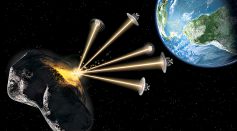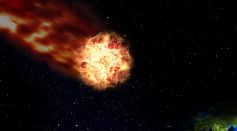Tags: Asteroid impact
Tunguska Event Mystery: Understanding the Largest Recorded Impact in History

Earth Has Three Times Higher Risk of an Asteroid Impact Than Previously Thought, NASA Warns

New Technique to Detect Killer Asteroids Developed for Planetary Defense Against Space Rock Impacts

Asteroid, Comet Threat: What is NASA's Plan When Space Rocks Hit Earth?

Dinosaurs Went Extinct Due to Sulfur Gases and Climate Cooling After Asteroid Impact, New Research Suggests

Asteroid Impacts the Inner Solar System for the Last 600 Million Years

Can Experts Protect the Earth from Asteroid Impact? New Way to Quickly 'Slice, Dice' a Giant Space Rock for Planetary Defense Proposed
Nuclear Detonations to Deflect Asteroids: Is It Possible?

Amazon Rainforest Origin: Did the Asteroid That Caused Dinosaur Extinction Started It?
Minimoon Orbits Earth for 3 Years, But No One Knew?

Evidence Shows Extraterrestrial Impact Caused Climate Change 12,800 Years Ago
Experts Warn Dangers Of Earth Getting Struck By Asteroids Ahead Of Asteroid Day On June 30
[WATCH] Large Asteroid Will Pass Near Earth Today; Live Streaming Of The Event Get It Here
Possible Scenario If An Asteroid Struck New York, San Francisco & Chicago
Asteroid Impact That Caused Dinosaur Extinction Results To Colorado Tectonic Faults
7 Deadly Asteroids Threaten Armaggedon; Nearest Celestial Approach Happened This Week [VIDEO]
An Asteroid Impact Resulted to Extinction of Ice Age Animals & Clovis People; Much Like the Fate of Dinosaurs
Most Popular

Largest Known Volcanic Aquifer Discovered Beneath Oregon's Cascades

New 'Supergiant' Sea Bug Found in South China Sea, Named After Darth Vader

Mediterranean Sea Was Refilled by a Catastrophic Flood Millions of Years Ago

Mysterious Cosmic Waves That Sound Like Birds Detected in Unexpected Space Region




